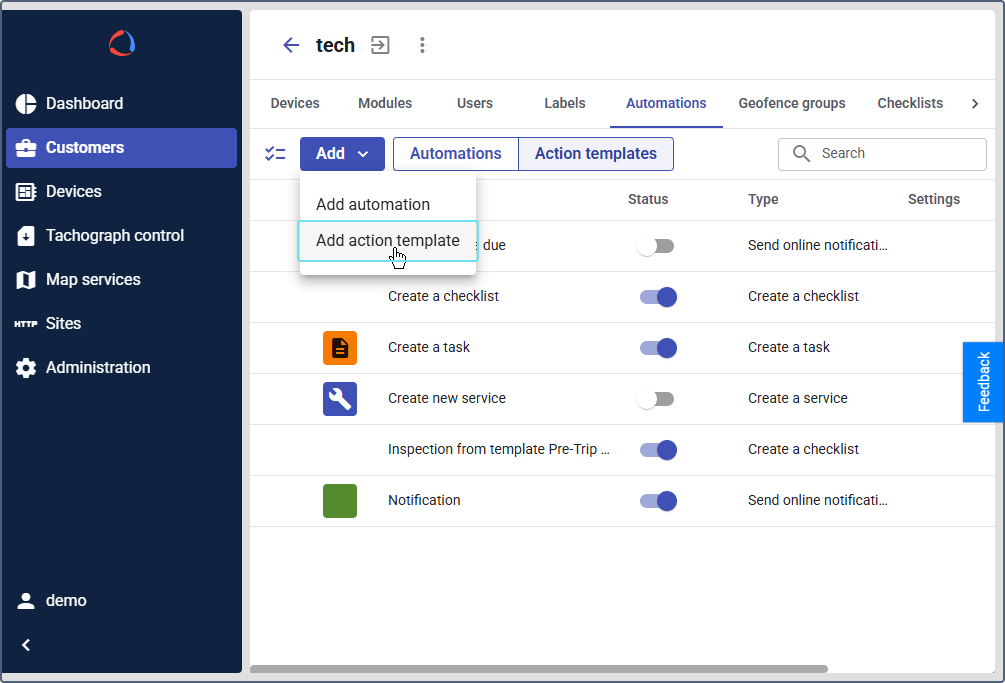Creating an action template
Who can do it: Service provider
Where: Wialon Platform Studio
Action templates are pre-configured actions that can be used within automations to perform specific tasks, such as sending notifications, assigning labels, or executing commands.
To create an action template:
- In Wialon Platform Studio, navigate to the Customers section.
- Select a customer from the list to open their details.
- Go to the Automations tab.
- Click on the Action templates sub-tab.
- Click the Add action template button.

- In the name field, enter a descriptive name for the action template. For example,
Alert, if the action sends a notification. - Set the toggle to Enabled to activate the template immediately, or Disabled to keep it inactive.
- Select the Action template type from the dropdown list. The available parameters will change based on your selection.
- After configuring all necessary parameters for the selected action template type, click Save.
Action template types and their parameters
Send online notification
This action displays a pop-up notification within the web or mobile application.
When linking the action template to the automation, in the Text field, use the available placeholders to include dynamic information in the text, such as speed, time, and geofences.
Send an email
The action sends an email to the indicated addresses. To do this, in the Recipient email address(es) field, enter one or more email addresses to which the message will be sent. Click the icon  to add more addresses, or the icon
to add more addresses, or the icon  to delete an address.
to delete an address.
When linking the action template to the automation, in the Text field, use the available placeholders to include dynamic information in the text, such as speed, time, and geofences.
Send Telegram message
The action sends an email to a Telegram chat. Indicate the following parameters:
- Telegram Channel ID: Enter the ID of the Telegram chat or channel. See how to connect a Telegram channel to Wialon in Wialon Hosting instructions.
- API Key: Enter the API key for Telegram integration.
When linking the action template to the automation, in the Text field, use the available placeholders to include dynamic information in the text, such as speed, time, and geofences.
Assign a label
The action assigns a label to the selected devices. Indicate the following parameters:
- Labels: Select the pre-configured labels to apply to the device that triggers the automation.
- Devices: Select the devices to which this action applies.
Remove a label
The action removes a label from the selected devices. Indicate the following parameters:
- Label: Select the specific label to remove from the device that triggers the automation.
- Devices: Select the devices from which this action removes a label.
Initiate an incident
This action automatically creates a new entry in the Incidents module. No additional parameters are required.
Execute a command
This action executes a command for the selected devices. Indicate the following parameters:
- Devices: Select the devices to which the command will be sent.
- Command template: Select a pre-configured command template to send to the device’s tracking unit.
Create a task
This action creates a new task in Tasks desk.
When linking the action template to the automation, in the Text field, use the available placeholders to include dynamic information in the text, such as speed, time, and geofences.
Create a service
This action creates a service for the selected devices. Indicate the following parameters:
- Priority level: Select the urgency level for the new service task: Urgent, High, Normal, or Low.
- Days to complete: Enter the number of days within which the service should be completed.
When linking the action template to the automation, in the Text field, use the available placeholders to include dynamic information in the text, such as speed, time, and geofences.
See the detailed instructions on creating a whole automation workflow using this action on the Creating a service automatically page.
Create a checklist
This action creates a checklist for the selected devices. Indicate the following parameters:
- Devices: Select the devices for which the checklist will be created.
- Template ID: Select the ID of the checklist template to use.
- User ID (assignee): Select the user to whom the checklist will be assigned.
See the detailed instructions on creating a whole automation workflow using this action on the Configuring automatic checklist assignment page.